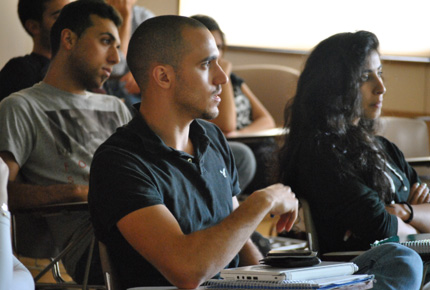LAU’s M.A. in Education new teaching emphasis on science, technology, engineering and math
MarCom met with faculty member Dr. Iman Osta to discuss the implementation of a STEM emphasis into the Master’s in Education.

In preparing for the new STEM emphasis, Dr. Iman Osta attended the annual “STEM Festival” in Washington DC where various educational concepts and tool were discussed and showcased.
Science, technology, engineering and math are at the core of a new approach in teaching known as STEM. A recent and growing trend, STEM is being incorporated into a number of education programs in the U.S. LAU, always keen to stay ahead of the curve, has also added STEM as an emphasis in its Master’s in Education program.
We asked the program’s co-developer Dr. Iman Osta — professor of math education and assistant dean of the School of Arts and Sciences — to elaborate.
MarCom: Why has LAU’s Department of Education revised its Master’s in Education program?
Dr. Osta: We previously offered separate emphases in math, science and early childhood. But there has been great demand for a shift in the way students are taught, particularly at the primary level. Now the knowledge and skills needed for each of these areas are incorporated into the new STEM emphasis. Instead of being content-driven, STEM is an approach to teaching that relies on a constructionist view of math and science.
MarCom: How does the STEM approach manifest itself in the classroom? Will math and science no longer be taught as separate subjects?
Dr. Osta: There is no absolute agreement among thinkers, educators, or universities about what STEM education is exactly. Some think of it as integration, others think of it as a pedagogical approach. Whether in math class or science, if you tap into other content, you are coming closer to STEM education, so there’s no need to cancel classes if we can introduce projects that cut across various disciplines and skill sets. Building a robot, for example, is a multi-disciplinary project that requires an understanding of basic skills in math, science, and technology and helps develop communication, cognitive and problem-solving skills.
MarCom: What is the value in introducing STEM in your program, when Lebanon’s national curriculum and schools do not adopt the approach?
Dr. Osta: The Lebanese curriculum of 1997 included a strong call for interdisciplinary teaching, but the reality is that the subjects covered by STEM are still fragmented and separated in government schools.
Our students however mostly go on to teach in private schools, where the approach is adopted in one form or another. In many good private schools in Lebanon we see integration at primary level with no schedule for separate subjects and one homeroom teacher who teaches the majority of the subjects, creating a suitable environment for the cross-discipline learning encouraged by the STEM approach.
MarCom: Greek philosophers excelled in many subjects, and generations ago students used to study under one teacher at the primary level. Are we not simply reinventing the wheel?
Dr. Osta: Over recent decades, a bureaucracy developed in the education system that led to the fragmentation of subjects. STEM was motivated by a general consensus in the U.S. that students graduating from schools and universities were not equipped enough to respond to the needs of the workplace. A political discussion in society then led to the development of STEM thinking.
The idea is to go back to the global person, and global knowledge, a more applied and integrated knowledge, in a more modern way that takes into consideration modern technology.
More
Latest Stories
- LAU Family Medicine Graduates to Benefit from a Partnership With Nova Scotia
- AKSOB Assistant Professor Shares Her Vision for the Future of Learning
- LAU Simulation Models Celebrate 20 Years of Learning, Leadership and Service
- The School of Engineering Hosts the Lebanese Electromagnetics Day
- LAU Stands Out on the Sustainability Scores
- Michael Haddad Walks Again for Climate Change and Food Security
- AI in Clinical Practice: Tools, Ethics, and the Human Touch
- Interior Design Students Honor the Past by Designing the Future

